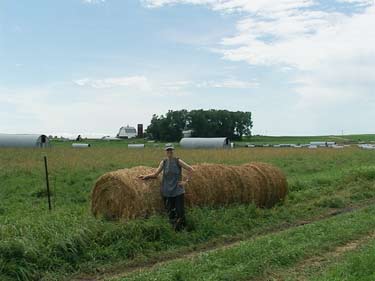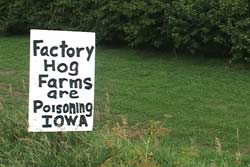[ Editor’s note: Before there was “Food Inc.”, before there was “FRESH”, “King Corn” and a host of other fine films about our food system, there was “As We Sow”, a hauntingly beautiful short film by director Jan Weber. To purchase this DVD, please refer to details at the bottom of her post. Run-time: 23 minutes; 2005] Watch Part 2; Part 3
I was born and raised in a small rural town in Wisconsin, but I’ve lived in Brooklyn, New York, so many years I have to count myself as a New Yorker, in all but accent. Still, as the saying goes, you can take the girl out of the country, but you can’t take the country out of the girl.
I started “documenting” in 2001, not “making a documentary” exactly, because I really didn’t know what it was going to end up being. The New York Times had run a series of articles about the disappearance of small towns across the Midwest, about communities drying up and farmers forced off the land. I wanted to understand what was happening, and I wanted to hear it from the farmers themselves. Armed with a new digital camera and equipment (that I had to teach myself how to use) and a book by a rural anthropologist, Kendall Thu, I traveled alone to Iowa where hogs are king and vastly more plentiful than people—and where small and midsized family farmers were losing their farms and leaving the land in droves.
According to the farmers in Kendall’s case studies, the hog industry and the market forces of consolidation, corporate control and agribusiness were turning once proudly independent farmers, those who could survive at all, into “serfs on the land” and “wage-earning hog janitors.” I didn’t know what that meant at first, but I did begin to see that not only had farming changed from what I remembered some 30 years back, but so had the very lay of the land. Where animals once grazed and hay, oats, and alfalfa were grown and harvested stood ramshackle barns—empty and useless in the middle of acres of soybeans and corn planted as far as the eye could see; no fences required. The hogs, like chickens before them, were confined in gleaming CAFOs, the new, ultra-efficient “barns” of industrialized farming, and surrounded by “lagoons” of liquefied manure. And while some towns flourished, most small communities had first lost their grocery store, then the hardware store, the school, and the families to go to the churches on Sunday. This is where I set up my camera and those farmers, and townspeople, and families who lost everything gave me an ear-full.
I named my film in honor of anthropologist Walter Goldschmidt, who, in the early 1940’s, was hired by the USDA to do a study on the effects on communities and people of large-scale farming versus small scale farming in the Central Valley of California. Agribusiness hated this study and it was summarily suppressed, only to be revived two decades later by Wisconsin’s Gaylord Nelson, who established As You Sow as the seminal sociological work on the effects of industrialized farming. I made one simple change: I named my documentary As We Sow, because I feel that we—consumers, farmers, advocates, activists, citizens rural and urban—are all part of what is sown, and what is reaped. Food revolutionary, Alice Waters, quoting a food revolutionary of the early 19th century, Brillat Savarin, says: “’The destiny of nations depends on the manner in which they are fed,’ and I would add that the destiny of nations depends on the way in which we raise our food.” What I discovered in Iowa, and in documenting farms and farmers and rural communities in Missouri, Illinois, Wisconsin, and Colorado over the years since then, is that there has indeed been change—some good and some bad. While CAFOs spring like a cancer in Iowa, and the public largely ignores the full consequences—environmental, political, cultural, social and ethical—there is also a counter-revolution going on. Size indeed matters, and so do people’s choices about how they farm and what they eat. It’s about the choices communities make about what matters to them, about what they need to do for growth and economic development that sustains a community or a region or a state over the long run. I also learned that we are all connected, that what happens in Iowa, happens to all of us.
One of the challenges all of us who are concerned about food, farm, and farmers is getting the word out, creating awareness, and hopefully, helping people act on that knowledge. That’s what documentary films should do and I hope in some small way, As We Sow contributes something to that effort.
Where Are the Farmers?
Our tour begins in the heart of Iowa where deserted farms stand idle in the empty landscape. Our guide is a former grain farmer: “It’s all farms here, but you’re not going to see any farmers…they’ve just disappeared; the buildings are here, but the farmers aren’t….You wake up and wonder what happened. People need to know this!”
Next time; As We Sow- Farming for Wages: Part 2
Jan’s career in television and film production spans some 35 years. Over that time she has produced, directed, and written commercials, corporate programs, network pilots, and co-produced two feature films. Through her marketing and communications consulting company, JW Creative Solutions, Ltd., she works with a myriad of corporate clients to plan, develop, and execute communications, marketing, and corporate education programs. As We Sow was Jan’s first documentary, (and not the last) and she continues to document food and farm from her no-so-rural perch in Brooklyn, NY. For additional information about her film, or to purchase the DVD, she can be contacted at janweber(AT)aswesow.com and at her website.



